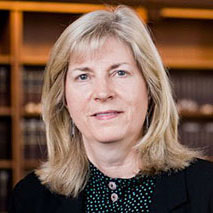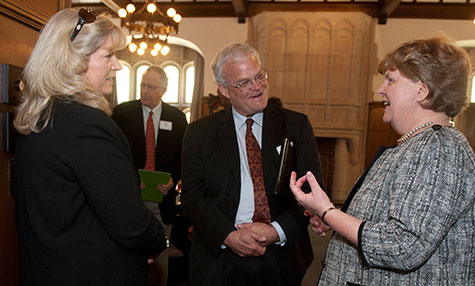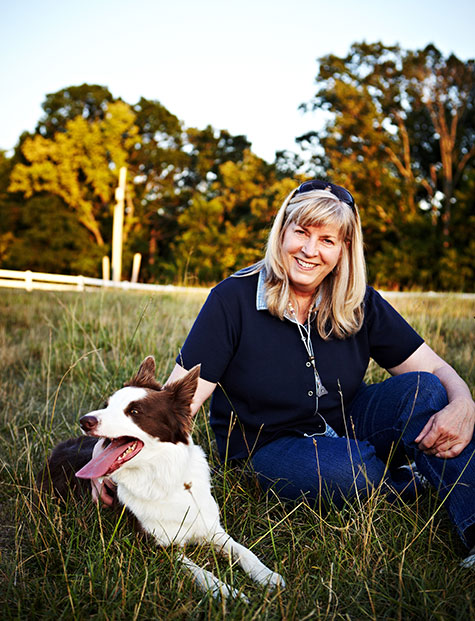
For Marion G. Crain, JD, vice provost and the Wiley B. Rutledge Professor of Law at Washington University in St. Louis, the power of collaboration is at the center of everything she does, from her teaching and scholarship to showing dogs and raising sheep.
“My life is pretty holistic,” she said in a recent interview.
“The common thread across all of my academic work is collective rights. I was drawn to labor unionism in part because I was interested in group rights, and that is a place in the law where they are explicitly protected. From there, I became interested in other social movements because I saw the power of group action and the fascinating ways that it interacts with rights consciousness to produce progressive legal reform.”
“Beyond the academy, I’m hooked on the partnerships I form with my dogs to accomplish particular goals, whether they be obedience training, conformation showing or sheep herding, where my border collies excel. In these endeavors, we work together as a team, which means learning to speak one another’s language and to trust that together, we can achieve things that neither of us could accomplish alone.”
Were you interested in labor and employment law when you started law school?
I have a bachelor’s degree in social work and initially thought that I would like to practice family law. After my first year of law school at UCLA, I was set to clerk for a local litigation firm in Westwood near Los Angeles. I showed up for work the first day (in 1982) and was marched down to the senior partner’s office, where I was told, “Sorry, the recession has hit us hard and we don’t have the funds to pay our summer and junior associates. You guys are all on your own.”
So I found a job working for the only firm that was still hiring, which was a small union-side labor law firm. The senior partner had recently had a heart attack, so I went to work for the junior lawyer, a young woman who didn’t know anything about labor law. I had never taken labor law, so we had to learn the law together: She asked me questions like, “The workers are going on strike at the plant. What can they write on the picket signs? Where can they stand?”
The answers to these questions had immediate, real-world impact, and I was hooked.
What prompted you to go into teaching?
I love to teach and am fascinated by how people learn. The judge that I clerked for on the 9th Circuit Court of Appeals taught at a Los Angeles law school as an adjunct, and he encouraged my interest. It’s a very common path for lawyers to go from a judicial clerkship into academia.
My favorite thing about teaching is hearing from students several years after graduation — when they start to realize who they are and how what they do fits with their own sense of self. They tell you some amazing things. They’ll talk about how they were impacted by something that happened while they were in school, a student group, a course, a paper or research experience that then led to a great career path. Those are the moments when you know that, somehow, you had something to do with this student getting to a place where he or she is happy and productive in the world; that’s very satisfying.

As part of your scholarship and teaching, you’ve brought together a number of disciplines across campus around labor issues and topics like income inequality. How do these types of connections relate to your role in the Provost’s Office?
I began to build these kinds of bridges through my work as director of the law school’s Center for the Interdisciplinary Study of Work & Social Capital. Together with directors of other centers across campus, particularly in the Brown School and in Arts & Sciences, I organized colloquia and conferences that led to interdisciplinary scholarship and publications.
As vice provost, I have two kinds of responsibilities that allow for even broader reach. The first entails initiating and coordinating interdisciplinary collaborations that lead to new courses and faculty partnerships that cross school lines. The “Interdisciplinary Teaching” and “Bring Your Idea” grants are ways we help get these collaborations off the ground. (For more information, visit provost.wustl.edu.)
Ultimately, we’re hoping to develop a new set of interdisciplinary courses that would offer all WUSTL freshmen the opportunity to see firsthand the benefits of thinking across disciplinary lines on big-picture topics like climate change, social inequality, entrepreneurship, or the digital age. This coming fall, we’ll launch a pilot course for freshmen on aging, taught by Nancy Morrow-Howell (Brown School), Brian Carpenter (Arts & Sciences) and Susy Stark (School of Medicine). The course will integrate intellectual and traditional classroom learning with experiential learning, service learning and exposure to career options in the field.
My second set of responsibilities as vice provost is to provide support to the directors of WUSTL’s university-wide institutes and research centers, including the Institute for Public Health, the Gephardt Institute for Public Service and the Danforth Center on Religion and Politics. The talented directors of these organizations advance our goals of furthering interdisciplinary teaching and research on a broad scale.
Why does interdisciplinary work matter?
No big social problem will be solved by a single approach. Public health is a great example. If you look at advancing public health as the challenge, your first inclination might be to say, “People with medical training are what’s required to solve that problem.”
But what about questions of access, how do people get physically into the building or places where they need to go in order to get the health-care services or information they need delivered? Now we are talking about design and architecture and people who think about how access to public transportation happens. It’s no good having a world-class medical facility that has great solutions to public-health dilemmas if you can’t get the services delivered to the people who need it. And legal and public-policy reform are essential to make the solutions to public-health challenges real; consider the Affordable Care Act and the controversy that has surrounded its enactment and implementation.
Any topic that you might choose to address — hunger, income inequality, climate change, the aging population, the challenges of a digital age, our desire to encourage entrepreneurship and business innovation — will benefit from a transdisciplinary approach. This is why there is a clear trend toward awarding large grants to transdisciplinary research partnerships as opposed to single- discipline initiatives. It’s the way of the future; this is how complex social problems will be solved.
Plus, our students are demanding interdisciplinary experiences. The number of students with double or triple majors has increased dramatically in recent years; our students want to think outside individual silos. Of course, it is also our obligation to ensure that they have a solid, deep foundation in their primary discipline(s), but we already do an excellent job with that.

Outside of the university, you’re working with quite a variety of animals — dogs, sheep and horses. What started you on this path?
I trained our family dog in 4-H when I was 13. She was unruly, and I was the oldest child, so I got the job. We went to a 4-H show, won a ribbon, and I was hooked.
How did sheep come into the picture?
The sheep are there for the border collies. I was fascinated by the breed’s incredible herding ability and desire to work — they are the ultimate workaholic breed, perfectly matched to me. And if you want to really develop their herding abilities in the partnership that it takes to control the sheep, you must have access to sheep. There is no better way to understand what makes sheep tick than to live with them.
It turned out to be a great hobby for me because it has taught me a lot about leadership and control. The goal of most herding competitions is to move sheep along a straight line through various obstacles, to place them in a pen, and to be able to separate a smaller group of designated sheep from the larger group. A well-trained dog can usually control where the sheep go, but the handler must provide effective direction. In order to do that, one must be observant enough to predict where sheep are likely to want to go, understand why and how they move as a group, and figure out when to push harder, when to back off, and how to adapt to constantly changing conditions. In a sense, sheepherding is a metaphor for how to nudge groups of people along toward consensus.
Of course, people are much more complicated than sheep! But the sheep give immediate, unmistakable feedback on the importance of knowing when to push forward, when to wait, and when to yield, and that set of skills is invaluable.
Plus, being outside with sheep and dogs is a great way to enjoy the beautiful rural countryside around St. Louis.